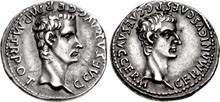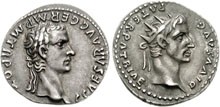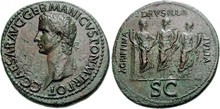NGC Ancients: Caligula
Posted on 3/12/2013
There are few figures in ancient history that provoke a reaction quite like that of the Roman Emperor Caligula (A.D. 37-41), who throughout the ages has become infamous for cruelty and depraved extravagance. This notorious emperor presents a challenge to historians who would seek to learn the true nature of his short reign, as the only surviving historical sources are biased against the man in all respects.
The last ten years of the reign of Tiberius (A.D. 14-37) were not happy ones for the ruling Julio-Claudian dynasty or for the Roman people. A growing paranoia began to influence the actions of the elderly emperor, and many people (including members of Caligula’s family) were executed on grounds of suspected treason. It was against this political backdrop that the Roman people were overjoyed to see Caligula succeed his great-uncle Tiberius upon the latter’s death in A.D. 37.
There was hope for a prosperous and peaceful reign during the first months of Caligula’s rule. The 24-year-old emperor was beloved by the Roman people as the son of the greatly admired general Germanicus (d. A.D. 19). He immediately abolished the treason trials of Tiberius and recalled all exiles, all the while giving a tremendous celebration in honor of his ascension.

Caligula soon began to issue coinage in his own name, such as this silver denarius, struck in the first year of his reign. Produced at Lugdunum, this piece features a portrait of the new emperor on the obverse, and that of his deceased father on the reverse. This represented a common trend of Caligula’s coinage – that of honoring deceased (and sometimes living) relatives such as his parents, Augustus, and his brothers and sisters.

Caligula sought to link himself to Augustus, founder of the Julio-Claudian family, as evidenced by this denarius, struck in the same year and location as the previous example. Again, Caligula is featured on the obverse, and a portrait of the deified Augustus, wearing a radiate crown, appears on the reverse.

In addition to his silver coinage, Caligula also issued examples in gold. This aureus, struck at Lugdunum in A.D. 37-38 depicts the emperor on the obverse and his mother, Agrippina Senior (d. A.D. 33), on the reverse.

One of the more infamous coins issued by Caligula was this so-called “Three Sisters” brass sestertius, struck at Rome in A.D. 37-38. The reverse features Caligula’s three sisters, from left to right: Agrippina Jr., Drusilla, and Julia in the guises of goddesses. Ancient historians put forth the claim that Caligula committed incest with his sisters and prostituted them out to other men, but these accounts cannot be verified, especially in light of the known bias that these writers harbored against this emperor.
Unfortunately, Caligula’s reign took a turn for the worse after he suffered a nearly-fatal illness in the fall of 37. His behavior became increasingly irrational and violent, especially against the Senate, the nobility, and the equestrian order. Just a few years later, he demanded that he be worshiped as a living god, which greatly offended the sensibilities of the Roman people.
Not surprisingly, plots against Caligula’s life sprang up with increasing frequency as his reign progressed and the violence escalated. After several failed attempts, a group of conspirators finally succeeded in stabbing the emperor to death on January 24, A.D. 41, making him the first (but far from the last) Roman emperor to be assassinated.
Images courtesy of Classical Numismatic Group.
Stay Informed
Want news like this delivered to your inbox once a month? Subscribe to the free NGC eNewsletter today!
